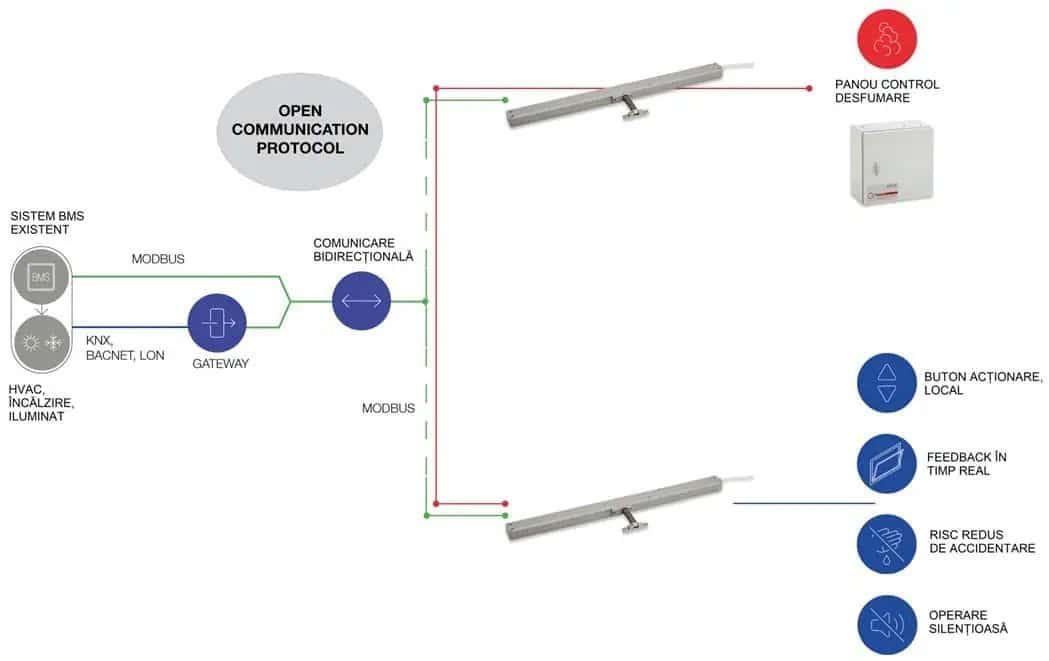Intelligent Systems for Automated Natural Ventilation
We are in an era where the demand for smart and energy-efficient buildings is increasingly important. Moreover, numerous studies highlight the importance of air quality for people who work, study, receive treatment, and spend many hours in modern buildings every day.
We all open a window to ventilate, to adjust the indoor temperature, and we all hurry to close that window if the wind intensifies or it starts to rain. Wouldn’t it be nice if everything happened automatically?
We should know that:
- The temperature difference between the sunny and shaded facade of the same building can be 7-8 degrees Celsius.
- The concentration of Radon or CO2 inside a building can rise to levels that endanger the health of occupants.
- Natural ventilation is the cheapest and most energy-efficient method of regulating the temperature inside buildings.
KADRA offers modern ventilation systems controlled by microprocessors, equipped with intelligent window actuators that can help ensure a healthy environment and optimal temperature in office buildings, schools and kindergartens, public institutions, universities, and libraries, etc.
Why Intelligent Electric Motors for Windows?
Electric actuators for windows with ventilation and/or smoke extraction functions have existed for several decades. Such a motor opens the window as long as it is powered by electricity or until it reaches the end of its stroke (the maximum possible stroke constructively). It behaves the same way when closing. It operates permanently at the maximum speed it is capable of.
The new generation of intelligent actuators (MOD Bus) for windows brings additional important advantages:
- Controlled operation (partial opening);
- Real-time feedback (bidirectional communication with the control unit);
- Customized command for each actuator in the network (actuators in the same network can receive different commands);
- Adjustable opening speed (reduced noise during ventilation, and maximum speed during smoke extraction).
Why an Intelligent Automated Natural Ventilation System?
Here are just 4 advantages of a ventilation system based on electric window actuators:
- Energy savings for heating/cooling the building (by relieving the air conditioning system at certain times) – between 10% and 21%.
- Additional “Green Building” certification credits – between 3% and 11%.
- Increased productivity of people working/studying in the building (due to improved air quality) – by 3-18%.
- Reduction in the occurrence of “sick building syndrome” – by 25-67%.
Additionally, intelligent actuators (BMS Line) can also be used for smoke extraction in case of fire: the actuator on the same window will operate at a lower speed (and thus more quietly) for ventilation, and in case of a fire alarm, the same actuator will operate at maximum speed and open the window to the maximum stroke (“full speed, full stroke”).
Intelligent automated natural ventilation systems can be integrated into both new projects and existing buildings (retrofitting) and there are two options for controlling intelligent window actuators:
- Integration into an existing BMS (Building Management System);
- Independent operation, controlled by a control unit.
The fire-resistant doors installed in the hospital in Pitești have technical approval EI in Romania for fire protection. They are fire-resistant for 90 and 120 minutes, constructed from galvanized steel casing with reinforced material inside, having a total thickness of 60 mm. The “Z” type frame on 4 sides is fixed with anchors or dowels and has a removable lower crossbar.
To complete the solutions designed to secure the hospital building in Pitești in case of fire, smoke vents were installed, compliant with current regulations, especially the European standard EN 12101-2, which are essential for protecting people and the building in case of fire. By automatically opening the smoke vents, hot gases and smoke are quickly evacuated, keeping emergency exits visible and thus protecting the people inside. This also ensures the entry of oxygen and the elimination of toxic gases.
Intelligent Window Actuators – Integration into Existing BMS System
Ensures:
- total control plus interaction and communication with other systems controlled by BMS (air conditioning, lighting, etc.)
- actuators have built-in “intelligence” – no additional control modules are required;
- each actuator has its own identity (unique IP address);
- permanent bidirectional communication, with real-time feedback;
- the window can also be controlled via a locally placed button;
- smoke extraction control units are directly integrated;
- 100% compatible with ANY BMS system (Modbus RTU, KNX, BACnet, Lonworks, etc.).

Window Actuators – Independent Operation
System features:
- autonomous system, equipped with temperature, wind, rain, CO2 sensors (for indoor air quality)
- monitors changing conditions inside and outside and operates windows to achieve/maintain optimal parameters;
- automatic reaction to rain and/or wind;
- local control, via button;
Besides the financial advantages (energy cost savings, Green Building credits, increased productivity, etc.), an automatic natural ventilation system contributes to ensuring a healthy microclimate in buildings, helps ensure good air quality, reduces CO2 concentration and dangerous gases (Radon, volatile organic compounds, etc.).
Of course, since children are more susceptible to the negative influences of harmful gases on health, public educational institutions (schools, kindergartens, nurseries) should be the first to benefit from automatic natural ventilation systems with intelligent window actuators.

KADRA specialists are at your disposal to identify the requirements of each project and assist you, step by step, in finding the optimal automatic ventilation and smoke extraction solution for any building, public or private.